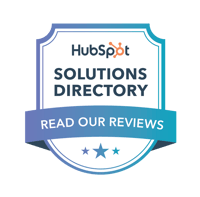One of the great things about HubSpot is the wealth of data at your fingertips. It's also one of the challenges of any business system.
It's easy to get stuck in analysis paralysis - and because the system doesn't magically know what metrics are most important to your business, it's hard to identify which metrics actually matter.
For your sales team, there is a huge wealth of HubSpot metrics to tap into, across all Hubs. The last thing you want is for your sales team to waste time digging through endless reports instead of following up with leads and landing sales.
We've spent enough time in HubSpot pulling sales data that we have a pretty good feeler for what matters to our customers. Of course, this is a general list - there may be other metrics that are incredibly valuable to your specific business. However, if you're looking for a place to start pulling KPIs, these 10 are the ones we recommend for nearly every business to track.
→Read Now: Why We Migrated Our Website From WordPress to HubSpot
10 Sales Metrics to Track in HubSpot
1. Revenue metrics
Revenue is ultimately what sales is all about, so naturally, it's a critical metric to track. There are several different ways of breaking down revenue for sales:
- Total revenue - The total amount of income generated from all operational and sales activities across all products and services.
- Revenue by product or service - The total income generated per individual product or service.
- Percentage of revenue from new business - How much income you’re generating from new customers every month or quarter.
- Percentage of revenue from existing customers - The income generated from cross-selling and upselling current customers, as well as from repeat orders and expanded contracts.
- Revenue by territory - The amount of income generated from sales in a certain territory.
- Revenue by market - Income generated from sales in a particular vertical.
2. Average customer lifetime value (LTV)
Average customer Lifetime Value (LTV) is the amount of revenue a business can expect from one user or customer throughout their lifespan with your company. This is key for sales to track because it helps identify streams of revenue and how much you can anticipate from each customer, and therefore understand the true ROI of each.
In turn, it helps you find commonalities between customers with a high lifetime value so your sales team knows which kinds of businesses or prospects to target.
3. Annual Contract Value (ACV)
Annual Contract Value is the amount of revenue a contract generates per year. Like LTV, it's important to track so you have clarity on what contracts are driving the highest value each year.
4. Monthly Recurring Revenue (MRR)
Monthly Recurring Revenue (MRR) tracks the total predictable revenue your company expects to make each month. Like with ACV, it's important to see which clients are driving value each month.
For businesses that charge monthly, this is clearly valuable, but it can also be valuable for eCommerce businesses to see how often customers are returning to place orders.
5. Customer Acquisition Cost (CAC)
Customer Acquisition Cost (CAC) is the average amount of sales and marketing expense required to acquire one new customer. This is an important metric - but also one of the few on this list that HubSpot doesn't calculate for you.
Instead, HubSpot allows you to track the data needed to calculate your CAC. The reason why it's not calculated by the system is because it involves some elements that can't be automated and can easily be inaccurate.
To calculate CAC, divide the total amount you spend on sales and marketing in a given time period by the number of customers you acquired in the same time period.
6. Average length of sales cycle
The amount of time it takes for leads to go through the sales pipeline until becoming a closed-won deal. This is an extremely important metric not just for your sales team, but also for your marketing, customer service, and management teams. Knowing your sales cycle's length will help you strategize marketing, touchbases, and follow-ups.
It also helps you know how to track revenue - the longer the sales cycle, the more you need to be aware of the time gap between when a lead enters the system and when they finally purchase.
→Read Now: How to Get Smarter Lead Tracking
7. Win rate
Win rate refers to the number of deals won divided by the total number of deals. It can be measured by the whole team and by an individual. This is an important metric to track to get insight about your sales team performance, as well as their current capacity.
8. Average lead response time
Another important metric for sales performance, average lead response time shows you how long it takes your sales team to follow up with a lead.
The places where you notice a long response time can show you where you need to add in automated emails so contacts get a follow-up right away, or potentially where you need to hire new salespeople to handle the amount of leads coming in.
9. Total open opportunities
Keeping with the trend of sales performance metrics, total open opportunities refers to the number of open deals by a team or individual. When paired with the average length of sales cycle metric, you can get insight into how well your sales team is closing open opportunities.
→Read Now: How to Get Your Sales Team to Actually Use HubSpot
10. Net Promoter Score (NPS)
Net Promoter Score (NPS) reflects whether a customer or user would recommend your business to another person. Generally, you calculate this by asking contacts "On a scale of 1-10, how likely are you to recommend us to a friend or colleague?"
Your current happy clients are a huge potential pool for future clients. Likewise, your unhappy clients can result in lost deals. For your sales team, it's critical to know both. Happy clients can be tapped into for networking and finding new leads. Unhappy clients are a chance to work with your customer service team to make things right.
Untangling the web of metrics within HubSpot can be incredibly overwhelming. Another way to cut through all the noise is to partner with a company that already knows how to dig through data and parse them into reports, so all you have to do is go to one spot and see everything you need.
Get the Most out of HubSpot Pro with a HubSpot Partner Agency
 BizzyWeb is a HubSpot Platinum Partner: we offer full-service HubSpot onboarding, enablement and strategy for all hubs. Our team has over 196 certifications in HubSpot (and constantly growing). No matter what your HubSpot needs are, our team is ready to handle them.
BizzyWeb is a HubSpot Platinum Partner: we offer full-service HubSpot onboarding, enablement and strategy for all hubs. Our team has over 196 certifications in HubSpot (and constantly growing). No matter what your HubSpot needs are, our team is ready to handle them.
Plus, we are the only agency in Minnesota with a Platform Enablement Accreditation from HubSpot - sounds fancy, but it means we're top-notch in making HubSpot work within your business.
BizzyWeb is a Minneapolis-based digital marketing and web design agency that helps companies get the high-quality leads they need to grow and thrive. Our tactics include inbound marketing, SEO, advertising, web design, content creation and sales automation. We are an accredited HubSpot Platinum Partner and we offer full-service HubSpot onboarding, enablement and strategy for new and current users.
Reference: The Ultimate Guide to Sales Metrics: What to Track, How to Track It, & Why, HubSpot





